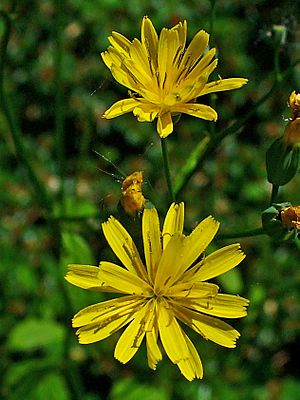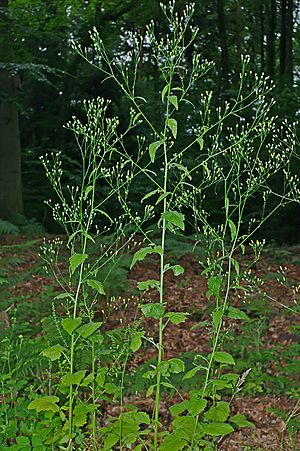Common nipplewort facts for kids
Quick facts for kids Common nipplewort |
|
|---|---|
 |
|
| Scientific classification | |
| Genus: |
Lapsana
|
| Species: |
communis
|
| Synonyms | |
|
Synonymy
Lapsana cancellata Borbás
Lapsana cappadocica Bornm. Lapsana crispa Willd. Lapsana glandulosa (Freyn) Klokov Lapsana olympica Candargy Lapsana pubescens Hornem. Lapsana sonchifolia Gilib. Lapsana sylvatica Wallr. Lapsana adenophora Boiss., syn. of subsp. adenophora Lapsana alpina Boiss. & Balansa, syn. of subsp. alpina Lapsana glandulifera Cass., syn. of subsp. grandiflora Lapsana grandiflora M.Bieb., syn. of subsp. grandiflora Lapsana lyrata Willd., syn. of subsp. grandiflora Lapsana aipetriensis Vassilcz., syn. of subsp. intermedia Lapsana intermedia M.Bieb., syn. of subsp. intermedia Lapsana macrocarpa Coss., syn. of subsp. macrocarpa Lapsana cassia Boiss., syn. of subsp. pisidica Lapsana peduncularis Boiss., syn. of subsp. pisidica Lapsana pisidica Boiss. & Heldr., syn. of subsp. pisidica Lapsana ramosissima Boiss., syn. of subsp. pisidica |
|
Lapsana communis, also known as the common nipplewort, is a type of flowering plant in the Asteraceae family. This family includes many well-known plants like sunflowers and daisies. This plant originally comes from Europe and southwestern Asia. However, it has spread and now grows naturally in many other places, including North America.
Contents
What the Common Nipplewort Looks Like
The common nipplewort is usually an annual plant. This means it lives for only one growing season. Sometimes, it can be a perennial plant, living for more than two years. It is a herbaceous plant, which means it has soft, green stems, not woody ones like trees.
Size and Stems
This plant can grow quite tall, reaching about 1 to 1.2 meters (around 3 to 4 feet). Its stems stand up straight and have small hairs on them. The plant has clear sap, which is the liquid inside its stems, unlike some plants that have milky sap.
Leaves
The leaves of the common nipplewort grow in an alternate and spiral pattern along the stem. The larger leaves near the bottom of the plant often look like feathers. They have a big oval-shaped main part and a few smaller parts on the sides. The smaller leaves higher up on the stem are usually simple ovals. All the leaves have edges that look like they have small teeth.
Flowers
The flowers are yellow and grow in small clusters at the top of the stem. Each flower cluster, called a capitulum or flower head, is about 1 to 2 centimeters (less than an inch) wide. Many of these clusters grow together in loose groups.
Flower Structure
Each flower head is surrounded by a ring of special leaves called involucral bracts. The outer bracts are very small, while the inner ones are tall, narrow, and stiff, all about the same length. Inside the flower head, there are 8 to 15 small flowers called florets. These florets are pale yellow and shaped like a tongue with five tiny teeth at the tip. Each floret has five stamens, which produce pollen, and a gynoecium, which is the female part of the flower. The gynoecium is made of two fused carpels.
Seeds
After the flowers bloom, the plant produces a fruit called a cypsela. This fruit holds many small seeds and is surrounded by the hardened parts of the involucral bracts. The seeds stay inside the cypsela until the plant is moved by wind or an animal. This helps the seeds spread. The plant does not have a Pappus, which is a feathery structure that helps some seeds fly in the wind.
Different Types of Nipplewort
There are several different types, or subspecies, of Lapsana communis. These include:
- Lapsana communis subsp. adenophora – found in Southeast Europe
- Lapsana communis subsp. alpina – found in Crimea
- Lapsana communis subsp. communis – found in most of Europe
- Lapsana communis subsp. grandiflora – found in Southwest Asia
- Lapsana communis subsp. intermedia – found in Southwest Asia and southeast Europe
- Lapsana communis subsp. pisidica – found in Greece
Where the Common Nipplewort Grows
The common nipplewort is originally from Europe and southwestern Asia. However, it has spread widely and now grows in many other parts of the world. It is very common in the British Isles. It has also become naturalized (meaning it grows there naturally now) in places like Australia, Chile, New Zealand, Greenland, and most of Canada and the United States. In some areas, it is even considered an invasive species, meaning it grows so well that it can take over from native plants.
You can find Lapsana communis growing in many different places. It likes to grow in farm fields, woods, along hedges, next to roads, in empty or unused land, and at the edges of forests or in areas where trees have been cut down.
How People Use Common Nipplewort
The young leaves of the common nipplewort are edible, which means you can eat them! They can be used in salads or cooked, much like spinach. Some people might prefer to mix them with other vegetables because the leaves have tiny hairs. The scientific name of the plant, lapsane, comes from an edible herb that was described by Marcus Terentius Varro in ancient Rome.
See also
 In Spanish: Lapsana communis para niños
In Spanish: Lapsana communis para niños


